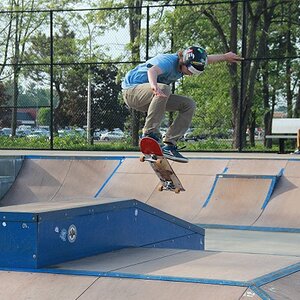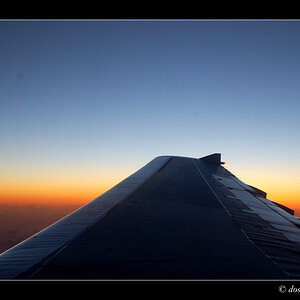- Joined
- Nov 11, 2003
- Messages
- 9,900
- Reaction score
- 119
- Location
- Ahwatukee, AZ
- Can others edit my Photos
- Photos NOT OK to edit
Interesting article here:
Why Digital Cameras Often Shoot the Pony But Get Only the Tail The Answer Is 'Shutter Lag,' The Bane of Shutterbugs; Photo Ops Become Oops
By WILLIAM M. BULKELEY, The Wall Street Journal
May 26, 2006
Glenn Maxwell vividly recalls the only whale-watching cruise he ever took, two years ago off Puerto Vallarta. As waves rocked the boat, he says, scores of the giant mammals leapt clear of the water.
Alas, Mr. Maxwell's memories of his Mexican adventure are better than his snapshots. Knowing a photo opportunity when he saw one, the Detroit computer programmer took dozens of pictures with his $500 Olympus digital camera. But each time he pressed the button, the camera paused, the whale flopped back in the ocean, and, Mr. Maxwell says, "I only got sky or sea."
Mr. Maxwell was the victim of "shutter lag" -- a maddening hesitation between the moment the button is pushed to take a picture and the time the picture is actually taken. Rarely an issue with traditional film photography, shutter lag is notorious among the 75 million owners of digital cameras, which use filmless imaging technology.
Digital photography is fast eradicating film. Consumers have embraced digital cameras because they eliminate the cost of film, they permit photographers immediately to review their pictures and retake bad ones, and they make it easy to store pictures on PCs, email them to friends and print high-quality photographs on home printers.
But most digital cameras still don't provide what every film camera does -- the ability to time a shot by pressing the button at the moment the baby smiles, the cat pounces or the Little Leaguer hits the ball.
Camera makers didn't want to take the snap out of snapshots when they developed digital cameras. But to hold down costs, they needed to make the specialized semiconductor that captures the image do a lot of preparatory work, calculating light levels and focal distance. Film can adjust to a wide variety of light levels; digital sensors need to carefully preset themselves or the image will be washed out or dim.
In the age of film, when the button was pressed, the picture was captured in an instant. In the vast majority of digital cameras, there's a delay that can last as long as two seconds.
To some users, it's another example of how advanced-technology products often lack important virtues of their predecessors. Cellphones often crackle with static that Ma Bell eliminated in rotary phones many years ago; computer printers need endless adjusting before they can print an address on an envelope -- a task that typewriters took in stride.
"I think we've really gone backwards on these technologies," complains Marcia Gregg, a mother of two from Boston who has a digital camera but still fondly recalls her Pentax from the 1980s that "was instantaneous and made a really cool sound" when its motor drive was running.
Camera makers say they have made digital shutter-lag a lot shorter on their newest cameras, especially higher-priced models. "Shutter lag has been reduced dramatically," says Darin Pepple, marketing manager for Fuji Photo Film Co.'s Fujifilm USA. "But the lower you go in price, the lower the speed because there's less processing power."
Rich Pelkowski, product manager for digital cameras for Olympus Corp.'s Olympus USA, says that shutter lag in point-and-shoot digital cameras "can be a real detraction to the total photographic experience." He says that Olympus, like other camera makers, has improved the speed of point-and-shoot cameras considerably in the past three years, with lag dropping to 0.7 to 1.5 seconds from 2 to 2.5 seconds when Mr. Maxwell bought his camera.
Jerry Magee, product manager for digital capture at Eastman Kodak Co., says that equaling the speed of film cameras is difficult, but technology will probably get there someday." Meanwhile, he says, photographers should prefocus by clicking the button halfway down. With new models that have a "burst" mode that shoots three or four shots in two seconds, photographers have a better chance of capturing the picture they want.
But many digital-camera buyers remain frustrated that their expensive purchases can't do what their old film cameras could. "With film, you see the shot -- you take it," says Douglas Katz, a neurologist at Boston University School of Medicine and father of two. Since going digital, he says: "I have missed many perfect child expressions, only to get the top of a head or half a body" because the children moved before the camera clicked.
Last June, hoping for faster picture-taking, he spent $800 on a second digital camera, a Konica-Minolta. But Mr. Katz is still dissatisfied. "My kids say, "I hate your new camera, Dad," when he tries to get them to pose long enough for him to get a shot, Mr. Katz says.
The Welsh ponies at her farm in Cornish, N.H., "look so good when they're going by," says Ginger A****er, a breeder and computer-systems manager. But when she recently asked a friend to shoot some with his digital camera, it kept snapping after they had passed. "We have a whole disk of pony tails. It's a little frustrating."
Other technological features can make the problems worse. David Goldenberg, a writer in Laguna Niguel, Calif., says that to reduce red eye in subjects, his digital camera preflashes ahead of the main flash illumination. But people who have been posed often relax their faces after the preflash. As a result, children in the pictures he snapped at his eight-year-old daughter's recent birthday party "have a vacant, dazed look," he says.
Single-lens-reflex digitals pioneered by Canon and Nikon last year have separate sensors for their automatic focus, greatly reducing shutter-speed problems, many users say. These cameras sell for about $800. Professional cameras, some going for about $4,000, employ multiple sensors and advanced software that cuts the delay still further. But features like these are out of reach for the average digital buyer, who spends about $300 for a camera, according to the Photo Marketing Association International.
Camera users without fancy lag-beaters resort to other techniques. Boston resident Jennifer Lowe says that during an African tour in 2004, she learned to anticipate where an animal was about to move. And "when setting up a shot with people, I'd press the button to take the photo and then tell people to smile."
Michele Souda, an executive-coach in Boston, missed shots with her first digital camera so "I would ask people to re-enact the moment -- even relighting the candles on the birthday cake." This year her husband bought her a new high-end Nikon she keeps in "sports mode" to capture her daughter. She says she's finally happy with digital photography.
But plenty of photographers are still struggling. "I hate the delay on my camera," a $400 Nikon CoolPix model, says Barney Geller, a Watertown, Mass., mother of two. Last month, in New York, her sons saw a man wearing a T-shirt that said "This is not a photo opportunity." The boys told her to shoot a picture when they snuck over to stand beside him, but by the time the camera clicked, the man had turned around.
Why Digital Cameras Often Shoot the Pony But Get Only the Tail The Answer Is 'Shutter Lag,' The Bane of Shutterbugs; Photo Ops Become Oops
By WILLIAM M. BULKELEY, The Wall Street Journal
May 26, 2006
Glenn Maxwell vividly recalls the only whale-watching cruise he ever took, two years ago off Puerto Vallarta. As waves rocked the boat, he says, scores of the giant mammals leapt clear of the water.
Alas, Mr. Maxwell's memories of his Mexican adventure are better than his snapshots. Knowing a photo opportunity when he saw one, the Detroit computer programmer took dozens of pictures with his $500 Olympus digital camera. But each time he pressed the button, the camera paused, the whale flopped back in the ocean, and, Mr. Maxwell says, "I only got sky or sea."
Mr. Maxwell was the victim of "shutter lag" -- a maddening hesitation between the moment the button is pushed to take a picture and the time the picture is actually taken. Rarely an issue with traditional film photography, shutter lag is notorious among the 75 million owners of digital cameras, which use filmless imaging technology.
Digital photography is fast eradicating film. Consumers have embraced digital cameras because they eliminate the cost of film, they permit photographers immediately to review their pictures and retake bad ones, and they make it easy to store pictures on PCs, email them to friends and print high-quality photographs on home printers.
But most digital cameras still don't provide what every film camera does -- the ability to time a shot by pressing the button at the moment the baby smiles, the cat pounces or the Little Leaguer hits the ball.
Camera makers didn't want to take the snap out of snapshots when they developed digital cameras. But to hold down costs, they needed to make the specialized semiconductor that captures the image do a lot of preparatory work, calculating light levels and focal distance. Film can adjust to a wide variety of light levels; digital sensors need to carefully preset themselves or the image will be washed out or dim.
In the age of film, when the button was pressed, the picture was captured in an instant. In the vast majority of digital cameras, there's a delay that can last as long as two seconds.
To some users, it's another example of how advanced-technology products often lack important virtues of their predecessors. Cellphones often crackle with static that Ma Bell eliminated in rotary phones many years ago; computer printers need endless adjusting before they can print an address on an envelope -- a task that typewriters took in stride.
"I think we've really gone backwards on these technologies," complains Marcia Gregg, a mother of two from Boston who has a digital camera but still fondly recalls her Pentax from the 1980s that "was instantaneous and made a really cool sound" when its motor drive was running.
Camera makers say they have made digital shutter-lag a lot shorter on their newest cameras, especially higher-priced models. "Shutter lag has been reduced dramatically," says Darin Pepple, marketing manager for Fuji Photo Film Co.'s Fujifilm USA. "But the lower you go in price, the lower the speed because there's less processing power."
Rich Pelkowski, product manager for digital cameras for Olympus Corp.'s Olympus USA, says that shutter lag in point-and-shoot digital cameras "can be a real detraction to the total photographic experience." He says that Olympus, like other camera makers, has improved the speed of point-and-shoot cameras considerably in the past three years, with lag dropping to 0.7 to 1.5 seconds from 2 to 2.5 seconds when Mr. Maxwell bought his camera.
Jerry Magee, product manager for digital capture at Eastman Kodak Co., says that equaling the speed of film cameras is difficult, but technology will probably get there someday." Meanwhile, he says, photographers should prefocus by clicking the button halfway down. With new models that have a "burst" mode that shoots three or four shots in two seconds, photographers have a better chance of capturing the picture they want.
But many digital-camera buyers remain frustrated that their expensive purchases can't do what their old film cameras could. "With film, you see the shot -- you take it," says Douglas Katz, a neurologist at Boston University School of Medicine and father of two. Since going digital, he says: "I have missed many perfect child expressions, only to get the top of a head or half a body" because the children moved before the camera clicked.
Last June, hoping for faster picture-taking, he spent $800 on a second digital camera, a Konica-Minolta. But Mr. Katz is still dissatisfied. "My kids say, "I hate your new camera, Dad," when he tries to get them to pose long enough for him to get a shot, Mr. Katz says.
The Welsh ponies at her farm in Cornish, N.H., "look so good when they're going by," says Ginger A****er, a breeder and computer-systems manager. But when she recently asked a friend to shoot some with his digital camera, it kept snapping after they had passed. "We have a whole disk of pony tails. It's a little frustrating."
Other technological features can make the problems worse. David Goldenberg, a writer in Laguna Niguel, Calif., says that to reduce red eye in subjects, his digital camera preflashes ahead of the main flash illumination. But people who have been posed often relax their faces after the preflash. As a result, children in the pictures he snapped at his eight-year-old daughter's recent birthday party "have a vacant, dazed look," he says.
Single-lens-reflex digitals pioneered by Canon and Nikon last year have separate sensors for their automatic focus, greatly reducing shutter-speed problems, many users say. These cameras sell for about $800. Professional cameras, some going for about $4,000, employ multiple sensors and advanced software that cuts the delay still further. But features like these are out of reach for the average digital buyer, who spends about $300 for a camera, according to the Photo Marketing Association International.
Camera users without fancy lag-beaters resort to other techniques. Boston resident Jennifer Lowe says that during an African tour in 2004, she learned to anticipate where an animal was about to move. And "when setting up a shot with people, I'd press the button to take the photo and then tell people to smile."
Michele Souda, an executive-coach in Boston, missed shots with her first digital camera so "I would ask people to re-enact the moment -- even relighting the candles on the birthday cake." This year her husband bought her a new high-end Nikon she keeps in "sports mode" to capture her daughter. She says she's finally happy with digital photography.
But plenty of photographers are still struggling. "I hate the delay on my camera," a $400 Nikon CoolPix model, says Barney Geller, a Watertown, Mass., mother of two. Last month, in New York, her sons saw a man wearing a T-shirt that said "This is not a photo opportunity." The boys told her to shoot a picture when they snuck over to stand beside him, but by the time the camera clicked, the man had turned around.


![[No title]](/data/xfmg/thumbnail/36/36654-55e621bd8f3203cdd106e3764c553c4d.jpg?1619737673)
![[No title]](/data/xfmg/thumbnail/32/32007-77c44b6b6edb5db977381096a2ffe54b.jpg?1619735151)
![[No title]](/data/xfmg/thumbnail/41/41798-aacfc8368463d919cba743fe318706b6.jpg?1619739897)
![[No title]](/data/xfmg/thumbnail/40/40286-86401b94de8b01bea8bb4ea154aaea0a.jpg?1619739408)


![[No title]](/data/xfmg/thumbnail/41/41799-fe172a668fba7717bf773664387d64aa.jpg?1619739897)
